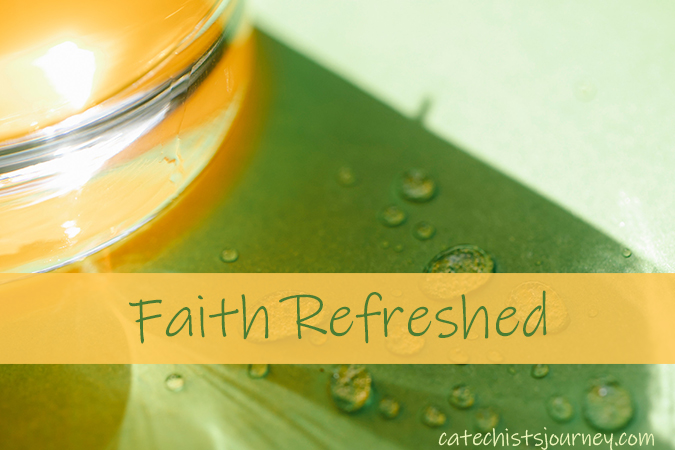
Welcome to Week 4 of Faith Refreshed, an online retreat to help us “hit the refresh button” in our spiritual lives so that we might better see things we weren’t previously seeing and return to our lives and ministry with a new outlook! Throughout this retreat, I am drawing from my best-selling book, A Well-Built Faith: A Catholic’s Guide to Knowing and Sharing What We Believe, as we re-visit the four pillars of our Catholic faith and invite the Holy Spirit to refresh our understanding of the basics of our faith and renew us in our efforts to proclaim the Good News to others.
Week 4: The Three Venues of Prayer (Christian Prayer)
Opening Prayer
Open yourself up to God’s presence through the 3-Minute Retreat: Transformed by Prayer.
Pray the Suscipe of St. Ignatius of Loyola.
Take, Lord, and receive all my liberty,
my memory, my understanding,
and my entire will,
All I have and call my own.
You have given all to me.
To you, Lord, I return it.
Everything is yours; do with it what you will.
Give me only your love and your grace,
that is enough for me.
Reflection
Take a moment to think of all of the ways we can communicate with someone nowadays:
- In person (orally)
- Handwritten note
- Text message
- Zoom meeting
- Tweet
- Cell phone call
- FaceTime
In today’s world, we have many different ways by which we can send and receive messages. In our prayer lives, as well, we have many different ways in which we can speak and listen to God. In particular, we can describe these forms of prayer according to three categories: vocal, meditative, and contemplative.
Think of it this way. Picture a very young couple, about 17 or 18 years old, deeply in love. They can’t get enough of talking to one another and are constantly calling, texting, and chatting. Now picture an elderly couple, married over 50 years, sitting on their porch swing, gently swaying back and forth without a word being spoken. Both couples are communicating with one another. One end of the spectrum relies mainly on words. At the other end of the spectrum, words no longer seem as necessary. That’s the same dynamic that we find on the spectrum of prayer.
Here’s an image to help you remember the three forms of prayer. Right before the Gospel at Mass, we make the Sign of the Cross over our forehead, lips, and heart, while silently praying, “May the word of God be in my mind, on my lips, and in my heart.” Mind, lips, and heart—these are the three “venues,” so to speak, of prayer.
- Vocal (lips)
- Meditative (mind)
- Contemplative (heart)
Vocal prayer, using words either spoken out loud or in the silence of our hearts, is the most natural form of prayer and, for most people, is the place where prayer begins. We can speak to God using our own words or using the words of traditional prayers and liturgical prayers such as the Liturgy of the Hours.
Meditation, or reflective prayer, is thinking about God—often with the aid of a Scripture passage, an inspirational reading, or sacred images. When we meditate, we attempt to become aware of—and “plug into”—God’s power and presence in our lives. Examples include the daily Examen, the Rosary, the Stations of the Cross, lectio divina and visio divina.
Often, the words meditation and contemplation are used interchangeably. Contemplation and meditation are not mutually exclusive. Meditation is often called contemplative prayer. Meditation leads to contemplation. However, a fine distinction is helpful. Meditation involves actively focusing. Contemplation is simply resting quietly in God’s presence. In contemplation, we do not attempt to speak to God but simply marvel at his glorious presence. It can be compared to enjoying a beautiful piece of art or a nature scene. No words are needed. An example of this is centering prayer.
No matter whether we are introverts or extroverts, we can find ways to enter into a deeper relationship with God through prayer. That means that we can truly pray without ceasing, knowing that prayer is much more than talking to God, but is our awareness of and response to God’s presence in our lives.
Meditation Song: “A Living Prayer”
Reflection Questions
Choose one of the following questions, and share your thoughts with your fellow retreatants by adding your comments below this post.
- Who is someone with whom you would feel comfortable sitting in silence?
- Who is the person you talk with the most? How often do you talk? What do you talk about?
- What can we learn about prayer from how we communicate in our relationships?
- What’s your favorite traditional prayer? When did you learn it and from whom?
- How do you feel about praying spontaneously? About leading others with a spontaneous prayer?
- What’s your favorite form of meditation?
- What kind of experience have you had with contemplation?
- What form of prayer were you introduced to for the first time in this article?
Prayer
Holy Spirit, you teach your people to pray through the guidance of the Church. Thank you for showing me so many ways to be in prayerful communion with you and with the Father and with Jesus. Help me to find the way to pray that is best for me right now in my life. Help me to grow in my prayer life, so that I may better recognize God’s presence in my life and respond by loving him and by loving my neighbors.
Additional Reading
- A Well-Built Faith: A Catholic’s Guide to Knowing and Sharing What We Believe
- The Words We Pray
- Guided Reflections for Children Vol. I
- Guided Reflections for Children Vol. II
- Shhh…God Is in the Silence
- A Simple, Life-Changing Prayer
- The Rosary as a Tool for Meditation
- The Daily Examen
- Ignatian Prayer and the Imagination
- The Contemplation on Divine Love
CCC References: 2697–2724
Photo by Charlotte May on Pexels.




Thank you so much Joe, fo rall you do for us.
What’s your favorite form of meditation?
My most favoritve form of mediation is listening to the ocean waves or soft tones. Sometimes I just like to set in the church with no sounds at all.
Thanks, Maxine…I love ocean waves as well!
Thank you for these retreats and reflections – really helpful.
What form of prayer were you introduced to for the first time in this article? Whilst I had used art as part of prayer I hadn’t heard the phase ‘visio divina’ and centering prayer was completely new to me. Thank you.
Thanks for sharing, Jan! Glad you’ve now been introduced to visio divina!
I learned traditional prayer from my parents as a child. It is the Our Father. My family said the Rosary nightly when it was on the radio back in the 50’s. My parents were active in our church community and passed that legacy on to me and my siblings.
Mary, thanks for sharing your experience praying the Rosary as a family.